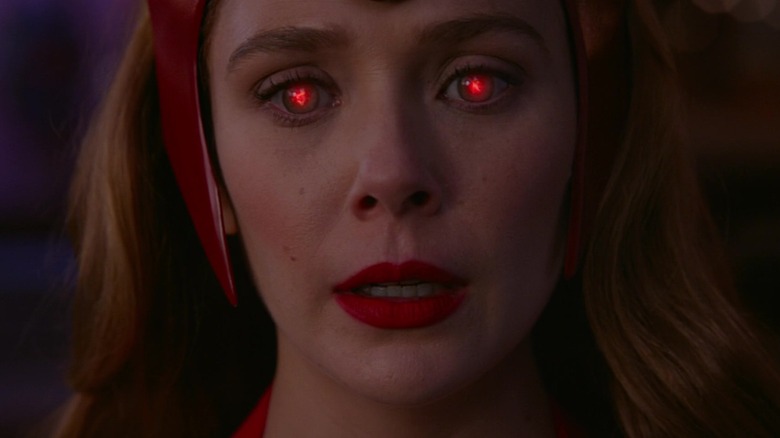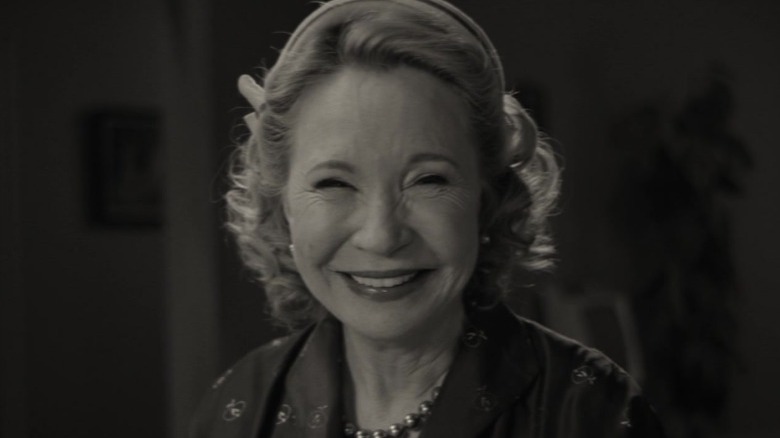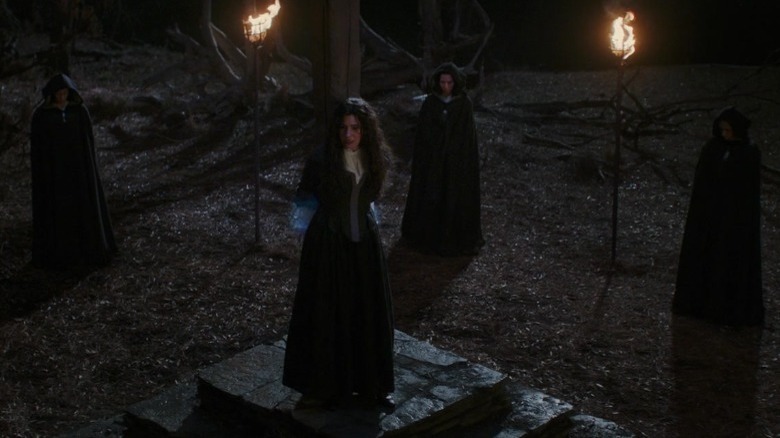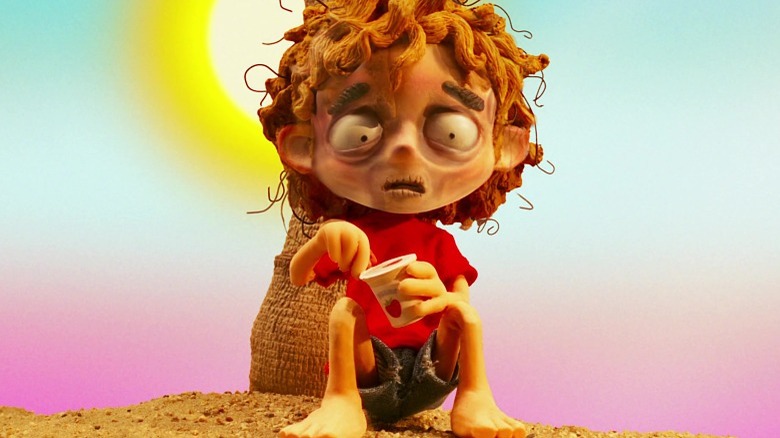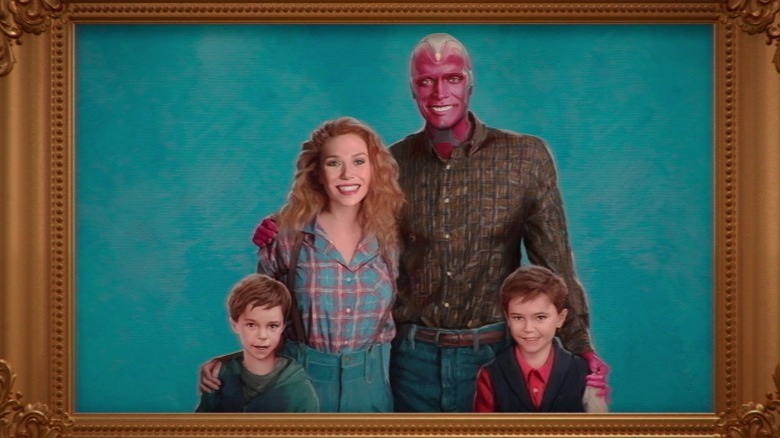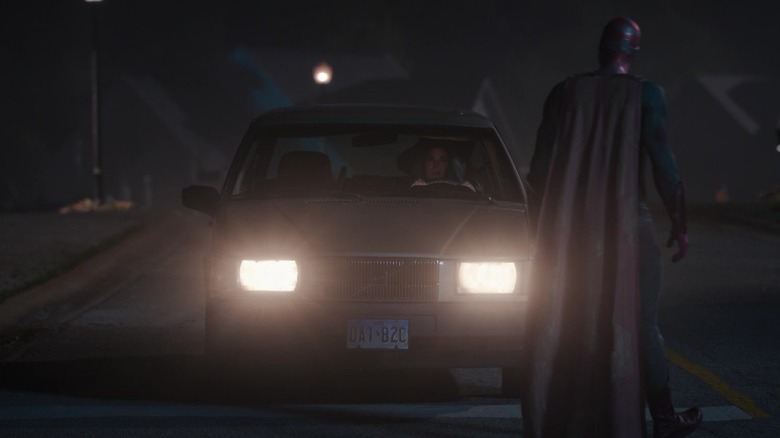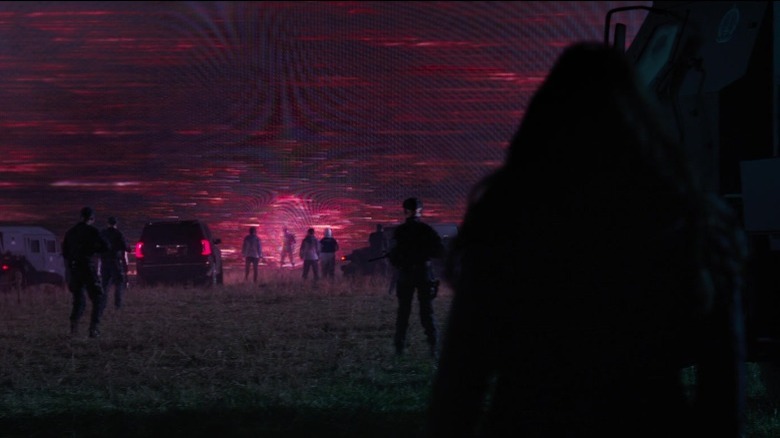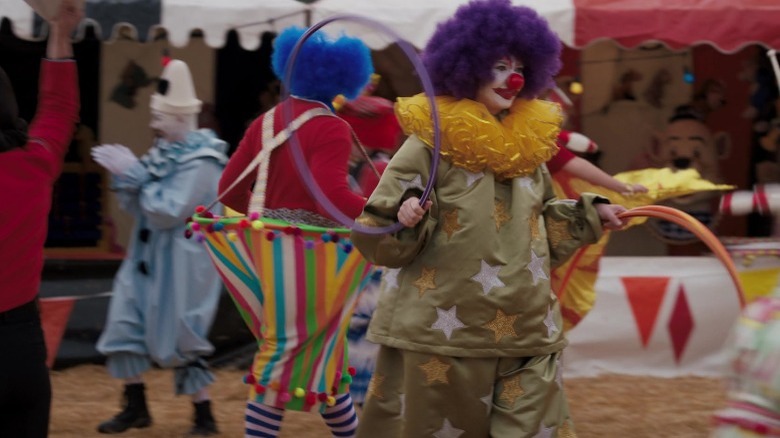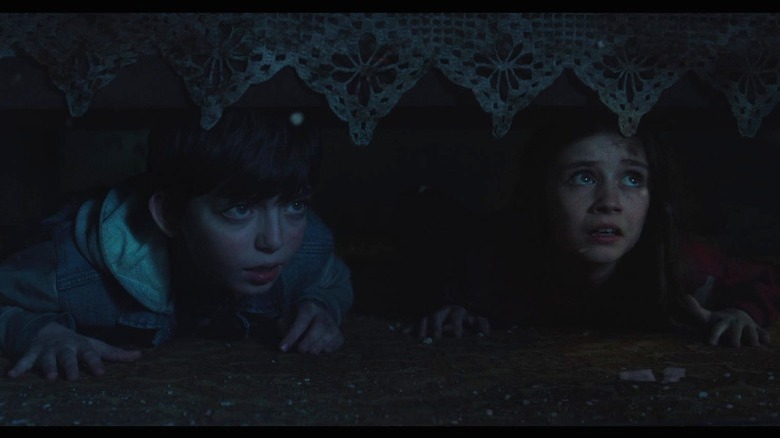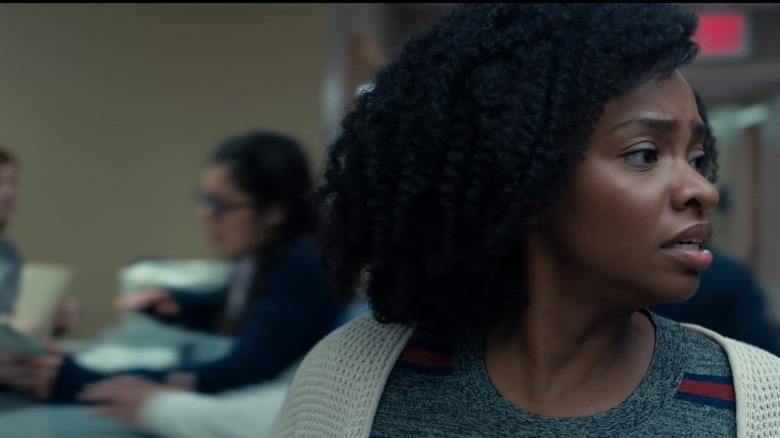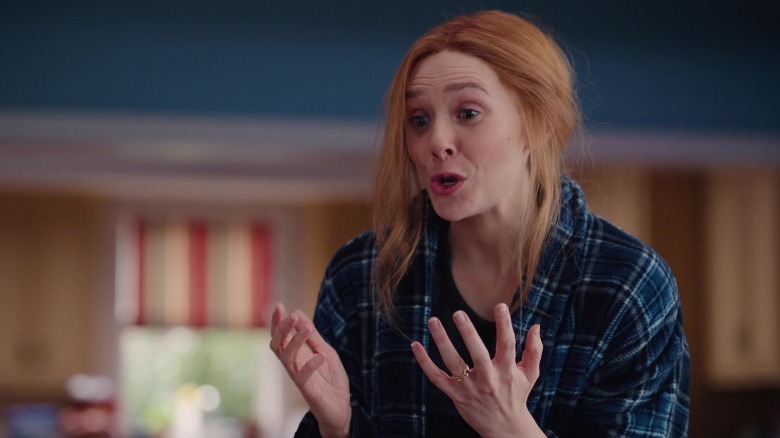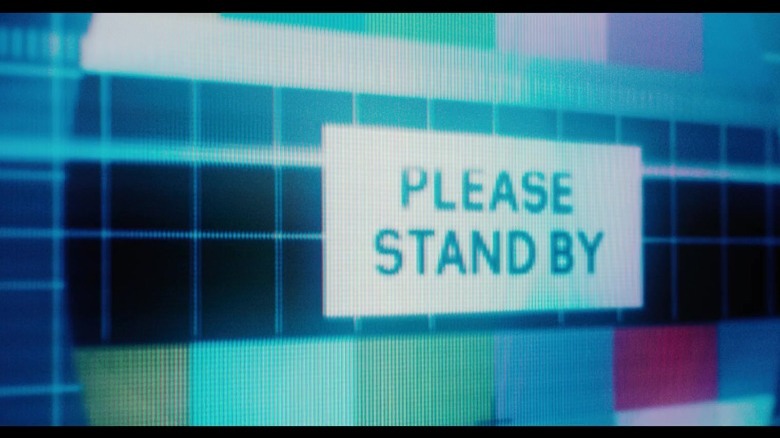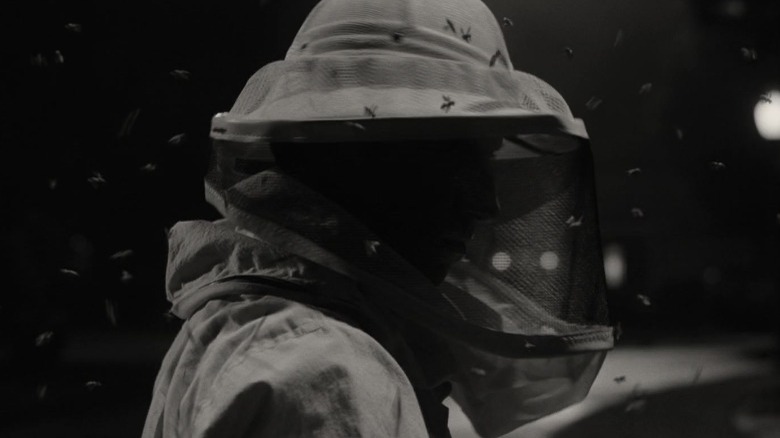Why WandaVision Is Creepier Than Anything Else In The MCU
If you think about the creepiest moments in the MCU, "WandaVision" might not be the first things that comes to mind. It's made to look like a sitcom, after all. What's so disturbing about that? Besides, Marvel has already given us plenty of scenes engineered to send shivers down the spine of audiences.
For instance, there's the skeletal likeness of Dr. Zola's face, displayed on HYDRA's supercomputer in "The Winter Soldier," not to mention the serial killer knocking off the Avengers in "What If...?" Episode 3. The Mandarin from "Iron Man 3" was pretty freaky (at least, until he was revealed to be Trevor Slattery.), and let's not forget the moment in "Infinity War" where Gamora thinks she has killed Thanos and feels horrible about it — even more eerie once Thanos manipulates reality and makes her wish she really had killed him.
But, "WandaVision" beats all of these, because the creep factor is present throughout the entire series, always crawling beneath the surface. Nobody expects a sitcom to be unsettling ("It's not that kind of show," says Wanda), which is exactly why the show gets under the skin of the viewer.
WandaVision defies genres, so viewers never know what to expect
The MCU installments are about superheroes, first and foremost. "WandaVision," however, is a bit more complicated, and that's it creates an uneasy sensation while watching it.
The show contains elements of sitcoms, horror movies, superhero films, and drama, yet never quite sticks to the rules of any of these. If it's a sitcom, certain things are expected — everything will be tied up in a neat little bow at the end of the episode. If it's a horror movie, it seems likely most of the characters will die. In a superhero movie, the hero will ultimately defeat the bad guy, even if he loses a few mentors or sidekicks along the way. Yet "WandaVision" keeps viewers guessing. One minute, Wanda (Elizabeth Olsen) is serving the Harts breakfast for dinner. The next, Mr. Hart (Fred Melamed) is choking to death and his wife (Debra Jo Rupp) can't stop laughing, which leaves the viewer feeling terrible for laughing just a moment ago.
Even after "WandaVision" explains why this Marvel story is being told in the form of a sitcom, conflicting expectations remain. Anytime the show starts to take a more upbeat turn, viewers need to brace themselves for the next twist, because it's likely too good to be true.
WandaVision avoids and subverts horror tropes
Underneath its sitcom facade, "WandaVision" contains horror elements. But it steers clear of horror cliches, which is more than can be said for some Marvel movies. Take "Iron Man," for example. Most likely, nobody was scared when the movie attempted a jumpscare in Obadiah Stane's lab, because that scene used all the oldest tricks in the book: an abandoned building, a pair of glowing eyes in the dark, and of course the classic trope of "Let's Split Up, Gang!" Viewers have seen the scenario so many times that it's more laughable than scary.
"WandaVision," however, shakes things up. The biggest jumpscare in the series was mostly played for laughs; Pietro (Evan Peters) appeared out of nowhere to say: "Snoopers gonna snoop." As a matter of fact, the Pietro character himself also puts a twist on another horror trope. It's not uncommon for horror movies to bring back a character who is supposed to be dead, only to reveal that it's too good to be true. But the thing about "WandaVision" is that the character back from the dead wasn't even the same person — Pietro had been "recast." It didn't even try to hide the wrongness of the situation.
What's more, the show reverses the whole "Salem witch" concept. When Episode 8 depicted a bunch of 17th-century villagers about to burn a woman at the stake, the default assumption is that the so-called witch is innocent. But "WandaVision" pulls a 180, revealing that Agatha (Kathryn Hahn) was an actual witch persecuted by her fellow witches, guilty as charged.
The show doesn't take itself too seriously
"WandaVision" gets insanely dark at times, but the show's creators always know precisely when to reel things in with a little humor. When a horror movie takes itself too seriously, it can be hard for audiences to take it seriously — just think of 1958's "The Blob." This Marvel show made sure to incorporate laughs, if only so that viewers would let down their guard.
Needless to say, the sitcom format offers plenty of comic relief, but some of the jokes tip into more disturbing territory. For instance, the yogurt commercial in Episode 6 began bright and colorful, before taking a twisted turn (the claymation kid starved to death because he couldn't peel the foil off the top of his yogurt). Then the commercial ended with the same buoyant voice-over as before, feeling like a slap in the face. It didn't hurt that this joke came right on the heels of a creepy moment with Vision. Also, don't not forget Pietro: He may not have seemed threatening running around the room doing his best impression of a vampire, but that's why it was so unnerving when he began messing with Wanda psychologically, kidnapping Monica (Teyonah Parris).
Here, the jokes didn't cheapen the creepiness; if anything, they intensify it. The stark contrast between the sitcom elements and the horror elements heightens the impact of each.
By comparison, it's hard to think of anything that has combined such comedic and horrific elements so effectively, short of the 2014 [adult swim] short "Too Many Cooks." Almost certainly an influence, that demented, viral phenomenon similarly harnessed its knowledge of sitcom tropes to create, and then subvert, expectations.
Everything is fake
One of the creepiest aspects of "WandaVision” was the gut-wrenching sensation that nothing was real. How could it be? It was all too good to be true. Up until Episode 8, Agatha didn't speak a single line that wasn't oozing with fakeness. Even Wanda was responsible for dozens of forced smiles in her attempts to maintain the illusion.
This artificiality is most jarring when juxtaposed beside the reality running just below the surface. Every time Vision (Paul Bettany) temporarily broke Wanda's control over the people of Westview, they would plead for a chance to see their loved ones and beg him to make her stop. Yet when they were swallowed once more by the hex, these characters went back to cracking corny sitcom jokes as if none of it ever happened. The effect was downright chilling.
Episode 3, in particular, escalated the feeling of fakeness into an intense paranoia. As Vision suddenly realized his neighbors in Westview were all conspiring against him, wondering what they really happened when he was out of earshot, the paranoia is reminiscent of "The Truman Show," a creepy film about a man whose entire life proved to be a reality TV show with him an unwilling participant. Just like "WandaVision," that film was set in a postcard-perfect suburbia that felt eerily fake. Vision desperately tried to escape the artificial world that had been created for him — the same as Jim Carrey's Truman — yet in both cases, the creators of these worlds just couldn't grasp why anybody would want to leave such a "perfect" world.
WandaVision strikes the ideal balance between terror and horror
Although it sounds like "terror" and "horror" are interchangeable, they are actually quite distinct. In fact, according to The Master's Review blog, they are almost complete opposites. Terror is the overwhelming fear of something that might happen (like knowing that Thanos is coming to Earth); horror is the shock and revulsion when these things actually happen (like Thanos snapping his fingers). Horror works best when it serves as a punchline after a long build-up of terror. The Snap wouldn't be half as devastating if the heroes hadn't spent the entire movie terrified of what would happen if Thanos won.
Like all the best horror stories, "WandaVision" knew terror is more powerful than horror. Sure, the debut season had occasional moments of horror, but it saved those moments for when they will hit the hardest. In terms of gore (which often goes hand-in-hand with horror), there was hardly any blood onscreen. But whenever there was a glimpse of blood, it packed a punch, precisely because no one was expecting it.
Most of the creepiest moments, however, relied on terror. Sparky didn't die onscreen, but the death is still utterly chilling. Agatha's story about Sparky eating her azalea leaves felt awfully fishy, raising the question of who else was going to disappear when Wanda wasn't looking. The same went for Vision's attempt to escape Westview; the entire sequence felt like driving in the dark, guided only by the feeble headlights of Agatha's eerily motionless car. It wasn't clear what would happen to Vision, but it seemed unlikely to be good.
Anything can happen if you pass through the Hex barrier
Perhaps the creepiest thing in the entire show was the Hex barrier: the shimmering wall that enclosed Westview, vaguely resembling a TV screen. Anyone that crossed through would have their mind and matter manipulated by Wanda. The Hex barrier fell squarely in "terror" territory, because you could never be sure what would happen when someone went through that wall.
To characters on both sides of the wall, the Hex barrier represented the unknown. Standing on the edge of it triggered a primal fear — not unlike what prehistoric ancestors must have felt gazing out into the dark night, not knowing what creatures lurked out there.
One of the most terrifying moments with the Hex barrier occurred in the final episode of the season, after Wanda had made up her mind to leave Westview. As she tucked Tommy (Jett Klyne) and Billy (Julian Hilliard) into bed, the shrinking red wall of the Hex barrier drew closer and closer. Wanda knew that Tommy and Billy would cease to exist once the barrier reached them, and after she kissed them goodnight, she would most likely never see them again. So, she closed the door on her way out, ensuring that viewers wouldn't get to see what happened to the boys when the wall finally caught up to them. Instead, "WandaVision" left it to the imagination of the viewer, which is infinitely more unsettling.
WandaVision has clowns in it
Yes, "WandaVision" contained clowns, a classic horror movie staple. The mere existence of clowns ought to be reason enough to classify it as a horror movie, but what the TV series did with those clowns only added to the creep factor.
When Wanda expanded the Hex barrier, it swallowed dozens of SWORD agents, and in the process transformed them into something that would graft more smoothly onto Wanda's world: a circus. While that sounds innocent enough, since all of Wanda's enemies who wanted to kill her are now her puppets, it becomes quite frightening that he does it without any noticeable deliberation.
Blissfully, Darcy (Kat Dennings) was spared the fate of clownhood. Instead, she ended up as an escape artist — a clever choice, since her character was partially the key to unlocking Vision's memories and helping the people of Westview escape.
The creepy things in the present stem from past trauma
"WandaVision" explored not only what scared its characters, but also why it scared them. All of Wanda's fears were rooted in past trauma, especially from her early childhood.
Episode 8 gave the audience glimpses of all the incidents in Wanda's backstory that planted the seeds for her fears. Wanda's parents were killed by a mortar shell manufactured by Stark Industries, so it's no wonder she shot down the drone sent by SWORD, throwing it down at their feet; such things trigger memories of the weapon that crashed down on her home and took away her family. Plus, fans who watched the previous Avengers films would notice that ghosts from Wanda's past was lurking in the background of every commercial. From the Strucker watches (a reference to Baron von Strucker, who experimented on Wanda) to Lagos paper towels (where she felt responsible for several deaths because she couldn't contain a suicide bomber), the experience was like mainlining someone else's deepest trauma.
There's a psychological reason behind all the eerie things that happened in "WandaVision." Knowing why these things occurred doesn't make them any less chilling; it made them hit harder.
The show hits a little too close to home for viewers
"WandaVision" made audiences uncomfortable because it reminded them of reality, at times more effectively than most other MCU entertainment. By pure coincidence, certain details in the show called to mind the COVID-19 pandemic, as the show debuted just under a year after the lives of everyone were impacted.
Such parallels appeared in Episode 4, as Monica woke up in a hospital flooded beyond its capacity when all the "blipped" people return. This sense of panic, uncannily familiar to anyone who'd been near a hospital throughout the pandemic, couldn't help but hit close to home. For the remainder of the series, the post-Snap world presented a hardened population, one that could be similar to the "New Normal" viewers would face when the pandemic finally recedes.
Of course, Marvel had already written and filmed most of "WandaVision" before the pandemic, though it did impact some additional filming in September 2020. Nevertheless, the series managed to be feel prophetic, which made it even creepier.
As the plot thickens, everything feels like it is unraveling
For the first half of the series, Wanda was in complete control of Westview. It was freaky, the way she could bend matter to her will the moment her eyes began glowing red. But things reached a whole new level of freakiness in the second half of the series, independent of Wanda's power.
In Episode 6, Wanda came to realize she couldn't fool Vision any longer — and by Episode 7, it became clear that her carefully-constructed world was falling apart. The objects in her home began flickering, switching between past versions of themselves. When her kids started asking what happened to Vision and Pietro, Wanda admitted she didn't have the answer — she's only their mother, after all — and maybe they should figure things out for themselves. This drastic change in Wanda felt particularly unsettling, because up until that point she wanted nothing more than to shelter her kids, but suddenly she didn't seem to bother. Any attempt at maintaining the illusion was abandoned; she could barely maintain the illusion for herself.
Wanda was the one who created this world, so what would happen when Wanda lost control? Audiences were left unmoored by this sensation that there was suddenly nobody at the wheel. In retrospect, it should have been obvious — each episode was set in a certain decade, and Wanda was rapidly running out of decades.
The score doesn't always match what's happening onscreen
The score of "WandaVision" offered a wide range of tonality, swinging from comical to unsettling. One of the reasons why the music got under the skin of the viewer was because, in certain scenes, the music would clash with what was actually happening, effectively striking a dissonant chord.
"There are moments when you make a certain piece of music go left instead of right," composer Christophe Beck said of this technique in a 2021 interview, "and it totally transforms how the scene feels to somebody watching it."
There are times when the score of "WandaVision" most definitely "goes left." For example, in Episode 7, when Tommy and Billy asked their mom what was happening, and the tender music lead us to expect that Wanda was about to give some heartfelt advice — until she shattered the illusion with the words: "I have no answers." The score then took a jarringly whimsical tone, as Wanda explained to her children that "everything is meaningless."
In a different interview, Beck said he specifically designed Wanda's theme (which played in the end credits, among other places) to be a double-edged sword, so it could toggle seamlessly between making Wanda sympathetic and making her seem like a threat. That end credit music boasted an eerie unpredictability to it, utilized well in the first two episodes (as the melody is ominous and creepy), then just when audiences had grown accustomed to it, yielding to a riff on the Monkees classic "Daydream Believer." Suddenly, nothing seemed comforting and predictable.
WandaVision finds the strange in the familiar
If a horror film gives you nightmares about ghosts or serial killers, that's nothing special. The subjects of these movies are naturally frightening, after all. But if it gives you nightmares about something that shouldn't be creepy at all, that is truly impressive. In that respect, "WandaVision" was perfect nightmare fuel.
The creepiest story in the MCU mastered the art of the uncanny — that uneasy feeling when the borders are blurred between the strange and the familiar. Throughout the first (and perhaps only) season of "Wandavision," there were plenty of innocent, familiar things tainted with a sense of dread.
Even though it was played for laughs, Wanda's accelerated pregnancy felt unsettling on a number of levels; it felt akin to horror movies like "Rosemary's Baby," where the characters become incubators to hatch grotesque monsters.
When Wanda inexplicably discovered a toy helicopter in her bushes, it shouldn't be creepy, yet it was. When the Hex barrier swallowed Monica's armored vehicle and spit out a station wagon, it shouldn't send shivers down the spine, yet it did. Even the sitcom format itself became twisted beyond recognition — to the point where up was down, humor became terror, and familiar plotlines devolved into chaos. It's safe to assume MCU fans will never look at beekeepers the same, ever again.
